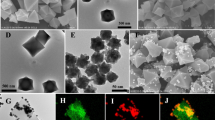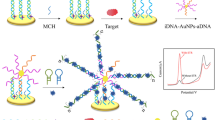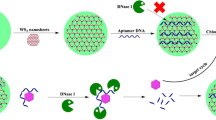Abstract
An electrochemical aptasensor, including the polyethyleneimine-graphite-like carbon nitride/Au nanowire nanocomposite (PEI-C3N4/AuNWs) and exonuclease-assisted signal amplification strategy was constructed for the determination of chloramphenicol (CAP). Initially, a nanocomposite with substantial electrocatalytic property was synthesized by PEI-C3N4/AuNWs. This improves the conductivity and specific surface area of the PEI-C3N4/AuNW–modified gold electrode. Next, a DNA with a complementary sequence to a CAP aptamer (cDNA) was immobilized on the PEI-C3N4/AuNW–modified electrode, followed by the CAP aptamer hybridized with cDNA. The lower signal at this time is due to the negatively charged phosphate group of the oligonucleotide and [Fe (CN)6]3−/4− electrostatically repelling each other. The presence of the CAP would cause aptamer on the electrode surface to fall off and be digested by Recjf exonuclease, which resulted in target recycling, and a significant increase in DPV signal can be observed at a potential of 0.176 V (vs. Ag/AgCl). Under optimal conditions, there is a linear relationship between the peak current and the logarithm of CAP concentration in the range 100 fM–1 μM, and the detection limit of this aptasensor is 2.96 fM (S/N = 3). Furthermore, the resultant aptasensor has excellent specificity, reproducibility, and long-term stability, and has been applied to the detection of CAP in milk samples.

The detection principle of the electrochemical aptasensor for CAP detection was based on PEI-C3N4/AuNWs and exonuclease-assistant signal amplification. It is based on the fact that PEI-C3N4/AuNWs nanocomposites on the surface of the electrode can effectively improve the performance of the aptasensor, and Recjf exonuclease initiates the target recycling process, causes signal amplification.






Similar content being viewed by others
References
Ehrlich J, Bartz QR, Smith RM, Joslyn DA, Burkholder PR (1947) Chloromycetin, a new antibiotic from a soil actinomycete. Ence 106(2757):417–417
Yan L, Luo CH, Cheng W, Mao W, Zhang DC, Ding SJ (2012) A simple and sensitive electrochemical aptasensor for determination of chloramphenicol in honey based on target-induced strand release. J Electroanal Chem 687:89–94
Hanekamp JC, Bast A (2015) Antibiotics exposure and health risks: chloramphenicol. Environ Toxicol Pharmacol 39(1):213–220
Smith AG, Dovey GJ, Cartwright RA (2015) Topical chloramphenicol and the risk of acute leukaemia in adults. Pharmacoepidemiol Drug Saf 9(3):215–219
Noa ER, Adi L, Yaara LW, Michal E, Mical P, Leonard L (2015) Efficacy and safety of chloramphenicol: joining the revival of old antibiotics? Systematic review and meta-analysis of randomized controlled trials. J Antimicrob Chemother 4:979–996
Wang LL, Yang H, Zhang CW, Mo YL, Lu XH (2008) Determination of oxytetracycline, tetracycline and chloramphenicol antibiotics in animal feeds using subcritical water extraction and high performance liquid chromatography. Anal Chim Acta 619(1):54–58
Li P, Qiu YM, Cai HX, Kong Y, Tang YZ, Wang DN, Xie MX (2006) Simultaneous determination of chloramphenicol, thiamphenicol, and florfenicol residues in animal tissues by gas chromatography/mass spectrometry. Se Pu 24(1):14–18
Ottonello G, Ferrari A, Magi E (2014) Determination of polychlorinated biphenyls in fish: optimisation and validation of a method based on accelerated solvent extraction and gas chromatography–mass spectrometry. Food Chem 142:327–333
Yan ZD, Gan N, Li TH, Cao YT, Chen YJ (2016) A sensitive electrochemical aptasensor for multiplex antibiotics detection based on high-capacity magnetic hollow porous nanotracers coupling exonuclease-assisted cascade target recycling. Biosens Bioelectron 78:51–57
Huang KJ, Liu YJ, Zhang JZ (2015) Aptamer-based electrochemical assay of 17β-estradiol using a glassy carbon electrode modified with copper sulfide nanosheets and gold nanoparticles, and applying enzyme-based signal amplification. Microchim Acta 182:409–417
Liu S, Lai GS, Zhang HL, Yu AM (2017) Amperometric aptasensing of chloramphenicol at a glassy carbon electrode modified with a nanocomposite consisting of graphene and silver nanoparticles. Microchim Acta 184(5):1445–1451
Pilehvar S, Dierckx T, Blust R, Breugelmans T, De Wael K (2014) An electrochemical impedimetric aptasensing platform for sensitive and selective detection of small molecules such as chloramphenicol. Sensors 14(7):12059–12069
Yadav SK, Agrawal B, Chandra P, Goyal RN (2014) In vitro chloramphenicol detection in a Haemophilus influenza model using an aptamer-polymer based electrochemical biosensor. Biosens Bioelectron 55:337–342
Yan MM, Bai WH, Zhu C, Huang YF, Yan J, Chen AL (2016) Design of nuclease-based target recycling signal amplification in aptasensors. Biosens Bioelectron 77:613–623
Wang YH, Xia H, Huang KJ et al (2018) Ultrasensitive determination of thrombin by using an electrode modified with WSe2 and gold nanoparticles, aptamer-thrombin-aptamer sandwiching, redox cycling, and signal enhancement by alkaline phosphatase. Microchim Acta 185:1–7
Zhu ZH, Qu LN, Niu QJ, Zeng Y, Sun W, Huang XT (2011) Urchinlike MnO2 nanoparticles for the direct electrochemistry of hemoglobin with carbon ionic liquid electrode. Biosens Bioelectron 26:2119–2124
Huang KJ, Yu S, Li J, Wu ZW, Wei CY (2012) Extraction of neurotransmitters from rat brain using graphene as a solid-phase sorbent, and their fluorescent detection by HPLC. Microchim Acta 176(3–4):327–335
Liu CS, Li J, Pang H (2020) Metal-organic framework-based materials as an emerging platform for advanced electrochemical sensing. Coord Chem Rev 410:213222
Hou H, Banks CE, Jing M, Zhang Y, Ji X (2015) Carbon quantum dots and their derivative 3d porous carbon frameworks for sodium-ion batteries with ultralong cycle life. Adv Mater 27(47):7861–7866
Zhu LM, Wang ZH, Wang LL, Li JJ, Cao XY (2019) ZnSe embedded in N-doped carbon nanocubes as anode materials for high-performance Li-ion batteries. Chem Eng J 364:503–513
Sui CJ, Zhou YL, Wang MY, Yin HS, Wang P, Ai SY (2018) Aptamer-based photoelectrochemical biosensor for antibiotic detection using ferrocene modified DNA as both aptamer and electron donor. Sensors Actuators B Chem 266:514–521
Liu YT, Wang QB, Lei JP, Hao Q, Wang W, Ju HX (2014) Anodic electrochemiluminescence of graphitic-phase C3N4 nanosheets for sensitive biosensing. Talanta 122:130–134
Chen YH, Liu XZ, Guo SL, Cao J, Zhou J, Zuo JL, Bai LJ (2019) A sandwich-type electrochemical aptasensor for Mycobacterium tuberculosis MPT64 antigen detection using C60NPs decorated N-CNTs/GO nanocomposite coupled with conductive PEI-functionalized metal-organic framework. Biomaterials 216:119253
Jiang X, Qiu XY, Fu GT, Sun JZ, Huang ZN, Sun DM, Xu L, Zhou JC, Tang YW (2018) Highly simple and rapid synthesis of ultrathin gold nanowires with (111)-dominant facets and enhanced electrocatalytic properties. J Mater Chem A 6(36):17682–17687
Xue SY, Yi HY, Jing P, Xu WJ (2015) Dendritic Pt@ Au nanowires as nanocarriers and signal enhancers for sensitive electrochemical detection of carcinoembryonic antigen. RSC Adv 5(94):77454–77459
Fu XL, Hou F, Liu FR, Ren SW, Cao JT, Liu YM (2019) Electrochemiluminescence energy resonance transfer in 2D/2D heterostructured g-C3N4/MnO2 for glutathione detection. Biosens Bioelectron 129:72–78
Li JS, Wang H, Guo ZK, Wang YG, Ma HM, Ren X, Du B, Wei Q (2017) A “turn-off” fluorescent biosensor for the detection of mercury (II) based on graphite carbon nitride. Talanta 162:46–51
Sun B, Dong J, Cui L, Feng TT, Zhu JJ, Liu XH, Ai SY (2019) A dual signal-on photoelectrochemical immunosensor for sensitively detecting target avian viruses based on AuNPs/g-C3N4 coupling with CdTe quantum dots and in situ enzymatic generation of electron donor. Biosens Bioelectron 124–125:1–7
Yalikun N, Mamat X, Li Y, Hu X, Wågberg T, Dong YM, Hu GZ (2018) Synthesis of an iron-nitrogen co-doped ordered mesoporous carbon-silicon nanocomposite as an enhanced electrochemical sensor for sensitive and selective determination of chloramphenicol. Colloids Surf B 172:98–104
Roushani M, Rahmati Z, Hoseini SJ, Fath RH (2019) Impedimetric ultrasensitive detection of chloramphenicol based on aptamer MIP using a glassy carbon electrode modified by 3-ampy-RGO and silver nanoparticle. Colloids Surf B 183:110451
Xie Y, Huang Y, Tang D, Cui H, Cao H (2018) A competitive colorimetric chloramphenicol assay based on the non-cross-linking deaggregation of gold nanoparticles coated with a polyadenine-modified aptamer. Microchim Acta 185:534
Qin X, Wang Q, Geng L, Shu X, Wang Y (2019) A “signal-on” photoelectrochemical aptasensor based on graphene quantum dots-sensitized TiO2 nanotube arrays for sensitive detection of chloramphenicol. Talanta 197:28–35
Chu TX, Vu VP, Tran HT, Tran TL, Tran QT, Le Manh T (2020) Molecularly imprinted polyaniline nanowire-based electrochemical biosensor for chloramphenicol detection: a kinetic study of aniline electropolymerization. J Electrochem Soc 167(2):027527
Funding
This study was financially supported by the National Natural Science Foundation of China (Grant No. 61301037), the Program for Science and Technology Innovation Talents in Universities of Henan Province (No. 20HASTIT002), the Cultivation Plan for Young Core Teachers in Universities of Henan Province (No. 2017GGJS072), and the National Engineering Laboratory for Wheat & Corn Further Processing, Henan University of Technology (No. NL2018004).
Author information
Authors and Affiliations
Corresponding author
Ethics declarations
Conflict of interest
The authors declare that they have no conflict of interest.
Additional information
Publisher’s note
Springer Nature remains neutral with regard to jurisdictional claims in published maps and institutional affiliations.
Supplementary information
ESM 1
(DOCX 385 kb)
Rights and permissions
About this article
Cite this article
He, B., Wang, S. An electrochemical aptasensor based on PEI-C3N4/AuNWs for determination of chloramphenicol via exonuclease-assisted signal amplification. Microchim Acta 188, 22 (2021). https://doi.org/10.1007/s00604-020-04688-8
Received:
Accepted:
Published:
DOI: https://doi.org/10.1007/s00604-020-04688-8




